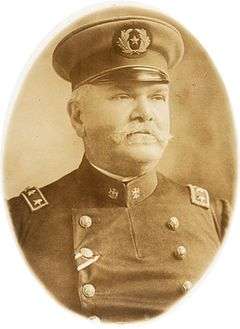Emil Körner
| Emil Körner | |
|---|---|
|
Emil Körner in the uniform of the Chilean Army | |
| Born |
Emil Körner Henze 1846 Prussia |
| Died |
March 25, 1920 Berlin |
| Nationality | Prussian |
| Employer | Government of Chile |
| Organization | Chilean Army |
| Title | Inspector General of the Chilean Army |
Emil Körner Henze (10 October 1846, Wegwitz – 25 March 1920, Berlin), sometimes called Emilio Korner Henze in Spanish, was a German officer (Hauptmann) of the Prussian Army and Commander-in-chief of the Chilean Army with the rank of Inspector General from 1900 to 1910.
Army modernization plans in Chile
After the War of the Pacific, the Government of President Domingo Santa María estimated that the Army needed to modernize and organize like European armies, according to the experiences that the conflict had left. The government set their sights on Germany, whose military establishment after the wars against Austria and against France stood out in Europe. In addition, the Chilean government had already touched on the overall progress of the country, with the influx of German immigrants to Chile. Following the idea of implementing the German military model, the Chilean embassy in Berlin contracted the services of the Prussian artillery captain Emilio Körner in 1885.
Chilean Civil War and rise to commander-in-chief
When the Chilean Civil War exploded in 1891, Körner sided with the Congress, which was only able to achieve control of the Chilean Navy while the Army, excepting several officers, sided President José Manuel Balmaceda. Partly due to his advices and actions during the Chilean Civil War, Emil Körner reached the rank of commander-in-chief of the Army (Inspector General del Ejército de Chile) in 1900.
Death
1910 he returned to Germany, was a war reporter for Chile during World War I, died 1920 in Berlin and was transferred to Chile 1924 upon request of the government. 1928 he was buried with military honors in an especially for him erected mausoleum in Santiago de Chile.
References
- Bibliography
- Jürgen Schaefer: Ayuda militar a Sudamérica, Intereses militares y defensivos en Argentina, Bolivia y Chile antes de 1914.
- Emilio Körner y Jorge Boonen: Estudios Sobre Historia Militar
- Emilio Körner: El desarrollo del Ejército Chileno
- Memorial del Ejército de Chile.'
